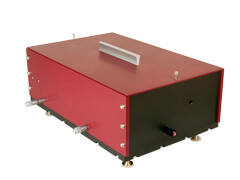APC dispersion compensation system
Negative dispersion up to -13000 fs^2@800 nm
Transmission >90%
Integration into Atseva’s laser systems
Automated adjustment

1. General
Stretching of fs pulses in microscopes due to dispersion introduced by optics is a well-known problem leading to substantial degradation of experimental results, especially with pulses shorter than 100 fs. The APC prism pulse stretcher/compressor unit provides control over the dispersion characteristics of your femtosecond laser radiation. The unit prepares femtosecond pulses to be positively dispersed while going through various optical elements of the microscope by introducing negative dispersion.
Thus, the pulse duration at the sample becomes equal to the input pulse duration before the microscope. The system has a bypass function that allows the beam to pass through unaffected.The APC-800/7000 model may also be used for other purposes that require pulse stretching or compression, as this model is able to introduce both negative and substantial positive dispersion values.
The unit can be automated with USB motors and PC software for easier control. The unit is best suited by the AA-M autocorrelator with two detectors for most precise pulse duration control at the input of your microscope and at the very sample position.
2. Specifications
3. Modifications
-M – motorized USB tuning of dispersion values with PC software.
4. Applications
Introduction of negative dispersion for further compression in optical systems for MPE microscopy
Dispersion control and pulse compression
5. FAQ
Q. Do you have an example of how broad the pulse may become when using a microscope?
A. For example, a transform-limited Gaussian-shaped pulse with duration of 100 fs at 800 nm is passing through microscope optics with total positive dispersion of 8000 fs^2, and that corresponds to pulse broadening to 254 fs.
Q. How can I know the dispersion of my microscope?
A. If it is an established producer of microscopic equipment, they might know the answer already. Just ask if they know the second order dispersion of their system at 800 nm or any other wavelength that is of interest to you.
Another way to go would be to purchase an autocorrelator with two photodetectors, one being able to measure pulse duration at the sample’s position of your system. Thus, you would be able to calculate the dispersion based on the difference in durations at the input and at sample position. This can be done by using our autocorrelator AA-M.
6. RFQ Hints
Just some quick hints before you send us an RFQ:
1. If you require the system to operate only with a microscope, then APC-800/13000 is your choice. However, if you require a more universal tool, check the specs of the APC-800/7000 to see if it is suitable.
2. If you require other dispersion values and other wavelengths please let us know and we will try to offer our customized solution.
